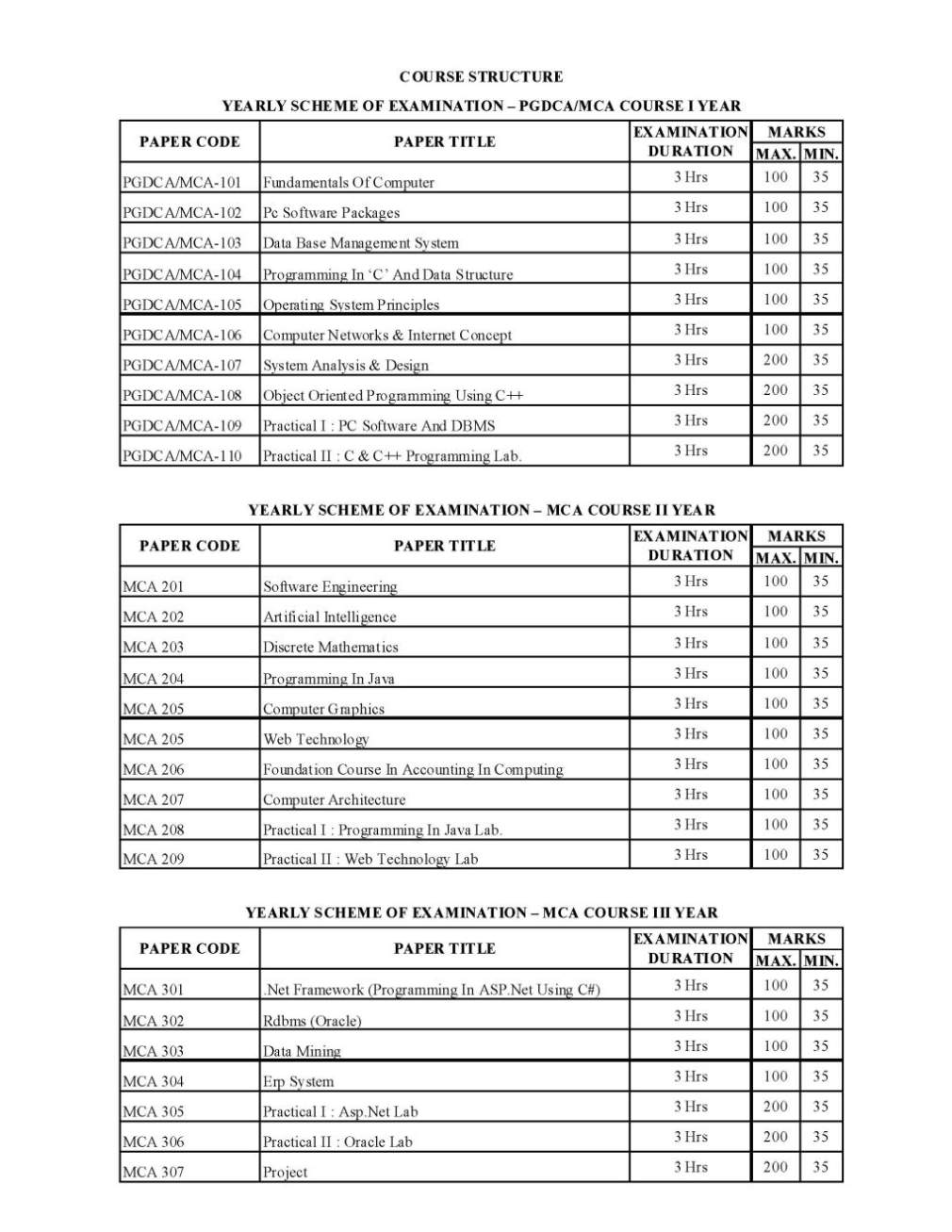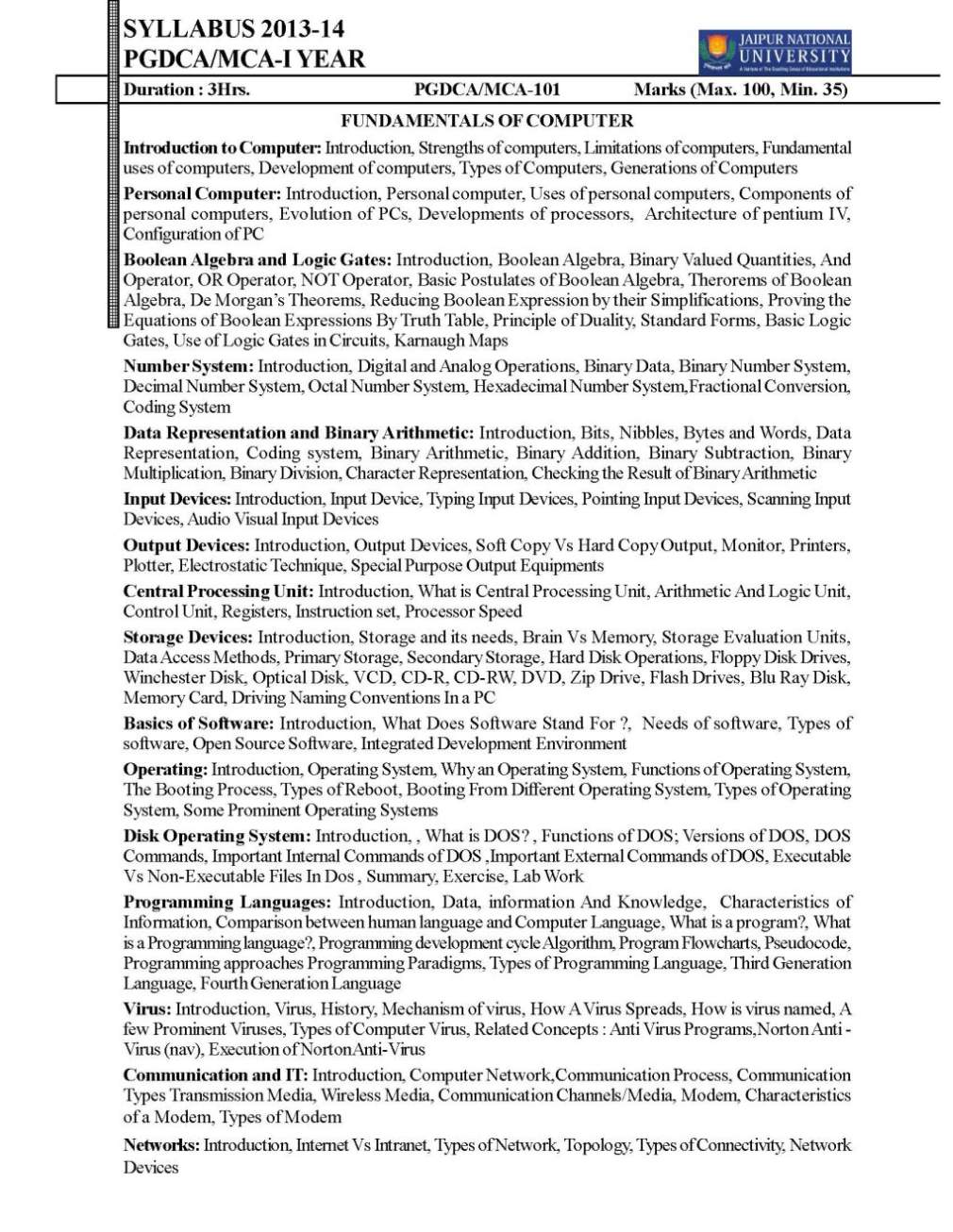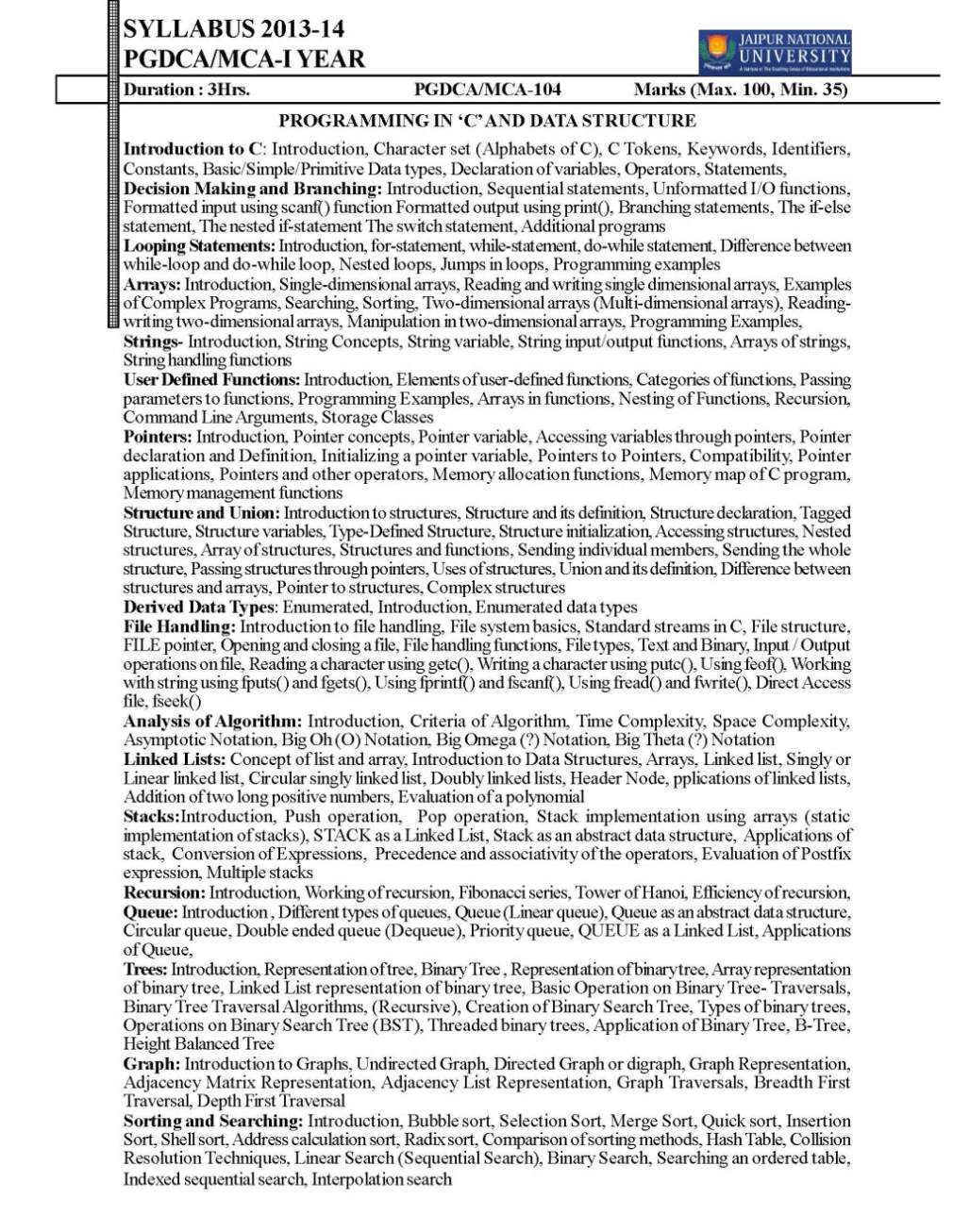| Re: Jaipur National University MCA Syllabus
You need Jaipur National University MCA programme detailed syllabus, here I am giving:
MCA Programme
1st SEM
Fundamentals Of Computer
Pc Software Packages
Data Base Management System
Programming In ‘C’ And Data Structure
Operating System Principles
Computer Networks & Internet Concept
System Analysis & Design
Object Oriented Programming Using C++
Practical I : PC Software And DBMS
Practical II : C & C++ Programming Lab
2nd Year
Software Engineering
Artificial Intelligence
Discrete Mathematics
Programming In Java
Computer Graphics
Web Technology
Foundation Course In Accounting In Computing
Computer Architecture
Practical I : Programming In Java Lab.
Practical II : Web Technology Lab
JNU MCA Syllabus
FUNDAMENTALS OF COMPUTER
Introduction to Computer: Introduction, Strengths of computers, Limitations of computers, Fundamental
uses of computers, Development of computers, Types of Computers, Generations of Computers
Personal Computer: Introduction, Personal computer, Uses of personal computers, Components of
personal computers, Evolution of PCs, Developments of processors, Architecture of pentium IV,
Configuration of PC
Boolean Algebra and Logic Gates: Introduction, Boolean Algebra, Binary Valued Quantities, And
Operator, OR Operator, NOT Operator, Basic Postulates of Boolean Algebra, Therorems of Boolean
Algebra, De Morgan’s Theorems, Reducing Boolean Expression by their Simplifications, Proving the
Equations of Boolean Expressions By Truth Table, Principle of Duality, Standard Forms, Basic Logic
Gates, Use of Logic Gates in Circuits, Karnaugh Maps
Number System: Introduction, Digital and Analog Operations, Binary Data, Binary Number System,
Decimal Number System, Octal Number System, Hexadecimal Number System,Fractional Conversion,
Coding System
Data Representation and Binary Arithmetic: Introduction, Bits, Nibbles, Bytes and Words, Data
Representation, Coding system, Binary Arithmetic, Binary Addition, Binary Subtraction, Binary
Multiplication, Binary Division, Character Representation, Checking the Result of Binary Arithmetic
Input Devices: Introduction, Input Device, Typing Input Devices, Pointing Input Devices, Scanning Input
Devices, Audio Visual Input Devices
Output Devices: Introduction, Output Devices, Soft Copy Vs Hard Copy Output, Monitor, Printers,
Plotter, Electrostatic Technique, Special Purpose Output Equipments
Central Processing Unit: Introduction, What is Central Processing Unit, Arithmetic And Logic Unit,
Control Unit, Registers, Instruction set, Processor Speed
Storage Devices: Introduction, Storage and its needs, Brain Vs Memory, Storage Evaluation Units,
Data Access Methods, Primary Storage, Secondary Storage, Hard Disk Operations, Floppy Disk Drives,
Winchester Disk, Optical Disk, VCD, CD-R, CD-RW, DVD, Zip Drive, Flash Drives, Blu Ray Disk,
Memory Card, Driving Naming Conventions In a PC
Basics of Software: Introduction, What Does Software Stand For ?, Needs of software, Types of
software, Open Source Software, Integrated Development Environment
Operating: Introduction, Operating System, Why an Operating System, Functions of Operating System,
The Booting Process, Types of Reboot, Booting From Different Operating System, Types of Operating
System, Some Prominent Operating Systems
Disk Operating System: Introduction, , What is DOS? , Functions of DOS; Versions of DOS, DOS
Commands, Important Internal Commands of DOS ,Important External Commands of DOS, Executable
Vs Non-Executable Files In Dos , Summary, Exercise, Lab Work
Programming Languages: Introduction, Data, information And Knowledge, Characteristics of
Information, Comparison between human language and Computer Language, What is a program?, What
is a Programming language?, Programming development cycle Algorithm, Program Flowcharts, Pseudocode,
Programming approaches Programming Paradigms, Types of Programming Language, Third Generation
Language, Fourth Generation Language
Virus: Introduction, Virus, History, Mechanism of virus, How A Virus Spreads, How is virus named, A
few Prominent Viruses, Types of Computer Virus, Related Concepts : Anti Virus Programs,Norton Anti -
Virus (nav), Execution of NortonAnti-Virus
Communication and IT: Introduction, Computer Network,Communication Process, Communication
Types Transmission Media, Wireless Media, Communication Channels/Media, Modem, Characteristics
of a Modem, Types of Modem
Networks: Introduction, Internet Vs Intranet, Types of Network, Topology, Types of Connectivity, Network
Devices
PC SOFTWARE PACKAGES
Office Packages-Office activities and their software requirement, word Processing, spreadsheet,
presentation graphics, database, introduction and comparison of various office suites like MS office, Lotus
Office, Star Office, Open Office etc.
MS Word Basics: Introduction to MS Office; Introduction to MSWord; Features & area of use. Working
with MS Word.; Menus & Commands; Toolbars & Buttons; Shortcut Menus, Wizards & Templates;
Creating a New Document; Different Page Views and layouts; Applying various Text Enhancements;
Working with – Styles, Text Attributes; Paragraph and Page Formatting; Text Editing using various features;
Bullets, Numbering, Auto formatting, Printing & various print options
Advanced Features of MS-Word: Spell Check, Thesaurus, Find & Replace; Headers & Footers ;
Inserting – Page Numbers, Pictures, Files, Auto texts, Symbols etc.; Working with Columns, Tabs &
Indents; Creation & Working with Tables including conversion to and from text; Margins & Space
management in Document; Adding References and Graphics; Mail Merge, Envelops & Mailing Labels.
MS Excel: Introduction and area of use; Working with MS Excel.; concepts of Workbook & Worksheets;
Using Wizards; Various Data Types; Using different features with Data, Cell and Texts; Inserting, Removing
& Resizing of Columns & Rows; Working with Data & Ranges; Different Views of Worksheets; Column
Freezing, Labels, Hiding, Splitting etc.; Using different features with Data and Text; Use of Formulas,
Calculations & Functions; Cell Formatting including Borders & Shading; Working with Different Chart
Types; Printing of Workbook & Worksheets with various options.
MS PowerPoint: Introduction & area of use; Working with MS PowerPoint; Creating a New Presentation;
Working with Presentation; Using Wizards; Slides & its different views; Inserting, Deleting and Copying of
Slides; Working with Notes, Handouts, Columns & Lists; Adding Graphics, Sounds and Movies to a
Slide; Working with PowerPoint Objects; Designing & Presentation of a Slide Show; Printing Presentations,
Notes, Handouts with print options.
Outlook express: Setup email account with outlook, sending and receiving mail through outlook, concepts
of CC and BCC, forwarding mail, Draft messages, formatting e-mail message, Concept of MIME, Protocol,
attaching files and items into messages, inserting hyperlink using outlook editor creating and using send and
receive groupemails, opening received messages, opening messages with attachment, replying to mail
forwarding messages flagging for further action, setting email options, managing contacts with outlook,
Setting up multiple email accounts on single machine.
DATA BASE MANAGEMENT SYSTEM
Introduction To DBMS: Operational Data, Introduction to database, Views of data, Three-Level
Architecture proposal, Instances and Schemas, Purpose of database system, Advantages of DBMS,
Disadvantages of DBMS, Structure of a DBMS, Data Models, Database Languages
E-R Model: Entity-Relationship Model, Entity and Entity set, Attributes and Keys, Relationship and
relationship set, Mapping constraints, Entity-Relationship diagram, Strong and Weak entities, Generalization,
Specialization, Aggregation, Reducing ER diagram to tables
RDBMS Concept And Terminology: Set theory - concepts and fundamentals, Extension and Intention,
Attributes and Domains, Relations, Tuple, Concepts of keys, Fundamental integrity rules
Normalization: Functional dependencies, Universal Relation, Anomalies in a database, Decomposition,
Normalization
Relational Algebra: Select Operation, Project Operation, Join Operation, Division Operation, Cross
Product Operation, Set operations, Set operations
Relational Calculus: Introduction, Tuple Relational Calculus, Operators used in TRC, Example queries
using TRC, Domain Relational Calculus, Operators used in DRC, Example queries using DRC, Comparison
of TRC, DRC, RA
Database Language: Integrity Constraints: entity integrity, referential integrity, Keys constraints, Domain
Constraints, Introduction to SQL: Characteristics of SQL, Advantage of SQL, SQL Data types and
literals, Types of SQL Commands, SQL operators and their procedure, Tables, views and Indexes, Queries
and Sub Queries, Aggregate functions, Insert, Update and delete operations, Joins, Unions, Intersections,
Minus, Cursors in SQL
Database Administration: DBA - Role, Functionality and Importance, Failure classification, The storage
hierarchy, RAID, Transaction model, File structure and Storage access, File organization, Organization of
records in file, Data dictionary storage
Advanced DBMS: Database system Architectures, Centralized System, Client-Server System, Parallel
Database System, Distributed Database System, Overview of Database on Web, Concepts of ODBC,
DSN
PROGRAMMING IN ‘C’ AND DATA STRUCTURE
Introduction to C: Introduction, Character set (Alphabets of C), C Tokens, Keywords, Identifiers,
Constants, Basic/Simple/Primitive Data types, Declaration of variables, Operators, Statements,
Decision Making and Branching: Introduction, Sequential statements, Unformatted I/O functions,
Formatted input using scanf() function Formatted output using print(), Branching statements, The if-else
statement, The nested if-statement The switch statement, Additional programs
Looping Statements: Introduction, for-statement, while-statement, do-while statement, Difference between
while-loop and do-while loop, Nested loops, Jumps in loops, Programming examples
Arrays: Introduction, Single-dimensional arrays, Reading and writing single dimensional arrays, Examples
of Complex Programs, Searching, Sorting, Two-dimensional arrays (Multi-dimensional arrays), Readingwriting
two-dimensional arrays, Manipulation in two-dimensional arrays, Programming Examples,
Strings- Introduction, String Concepts, String variable, String input/output functions, Arrays of strings,
String handling functions
User Defined Functions: Introduction, Elements of user-defined functions, Categories of functions, Passing
parameters to functions, Programming Examples, Arrays in functions, Nesting of Functions, Recursion,
Command Line Arguments, Storage Classes
Pointers: Introduction, Pointer concepts, Pointer variable, Accessing variables through pointers, Pointer
declaration and Definition, Initializing a pointer variable, Pointers to Pointers, Compatibility, Pointer
applications, Pointers and other operators, Memory allocation functions, Memory map of C program,
Memory management functions
Structure and Union: Introduction to structures, Structure and its definition, Structure declaration, Tagged
Structure, Structure variables, Type-Defined Structure, Structure initialization, Accessing structures, Nested
structures, Array of structures, Structures and functions, Sending individual members, Sending the whole
structure, Passing structures through pointers, Uses of structures, Union and its definition, Difference between
structures and arrays, Pointer to structures, Complex structures
Derived Data Types: Enumerated, Introduction, Enumerated data types
File Handling: Introduction to file handling, File system basics, Standard streams in C, File structure,
FILE pointer, Opening and closing a file, File handling functions, File types, Text and Binary, Input / Output
operations on file, Reading a character using getc(), Writing a character using putc(), Using feof(), Working
with string using fputs() and fgets(), Using fprintf() and fscanf(), Using fread() and fwrite(), Direct Access
file, fseek()
Analysis of Algorithm: Introduction, Criteria of Algorithm, Time Complexity, Space Complexity,
Asymptotic Notation, Big Oh (O) Notation, Big Omega (?) Notation, Big Theta (?) Notation
Linked Lists: Concept of list and array, Introduction to Data Structures, Arrays, Linked list, Singly or
Linear linked list, Circular singly linked list, Doubly linked lists, Header Node, pplications of linked lists,
Addition of two long positive numbers, Evaluation of a polynomial
Stacks:Introduction, Push operation, Pop operation, Stack implementation using arrays (static
implementation of stacks), STACK as a Linked List, Stack as an abstract data structure, Applications of
stack, Conversion of Expressions, Precedence and associativity of the operators, Evaluation of Postfix
expression, Multiple stacks
Recursion: Introduction, Working of recursion, Fibonacci series, Tower of Hanoi, Efficiency of recursion,
Queue: Introduction , Different types of queues, Queue (Linear queue), Queue as an abstract data structure,
Circular queue, Double ended queue (Dequeue), Priority queue, QUEUE as a Linked List, Applications
of Queue,
Trees: Introduction, Representation of tree, Binary Tree , Representation of binary tree, Array representation
of binary tree, Linked List representation of binary tree, Basic Operation on Binary Tree- Traversals,
Binary Tree Traversal Algorithms, (Recursive), Creation of Binary Search Tree, Types of binary trees,
Operations on Binary Search Tree (BST), Threaded binary trees, Application of Binary Tree, B-Tree,
Height Balanced Tree
Graph: Introduction to Graphs, Undirected Graph, Directed Graph or digraph, Graph Representation,
Adjacency Matrix Representation, Adjacency List Representation, Graph Traversals, Breadth First
Traversal, Depth First Traversal
Sorting and Searching: Introduction, Bubble sort, Selection Sort, Merge Sort, Quick sort, Insertion
Sort, Shell sort, Address calculation sort, Radix sort, Comparison of sorting methods, Hash Table, Collision
Resolution Techniques, Linear Search (Sequential Search), Binary Search, Searching an ordered table,
Indexed sequential search, Interpolation search
OPERATING SYSTEM PRINCIPLES
Operating System: Introduction of Operating System, Types of Operating System, System Components
and it’s services, System Calls, System Programs, Structure, Design and , Implementation, Operating
System Generation
Process: Concept, Description and Control, Concept of process, Process state model, Process description
– PCB, Process control, Threads, Threads in Linux
Process Scheduling: Types of Scheduler, Scheduling Criteria, Uniprocessor Scheduling, Multiprocessor
Scheduling, Algorithm Evaluation, Process Scheduling in Linux
Process Synchronization and Deadlocks: The Critical-Section problem, synchronization hardware,
Semaphores, Classical problems of synchronization, Critical Regions, Monitors, Deadlocks-System Model,
Characterization, Deadlock prevention, Avoidance and Detection, Recovery from deadlocks, Combined
approach to deadlock handling.
Security and Protection: Protection and Security-Goals of Protection, Domain of Protection, Access
Matrix, Implementation of Access Matrix, Revocation of access rights, Language Based Protection, The
Security Problem. Authentication, One Time passwords, Program threats, System threats, threats monitoring,
Encryption
Memory Management: Memory Management Requirements, Address Space, Linking and Loading,
Swapping, Partitioning, Paging, Segmentation
Virtual Memory: Introduction to Virtual Memory, Demand Paging, Page Replacement, Thrashing, Demand
Segmentation, Solved Problems
Input Output Systems: Input - Output Devices, Hardware Support for I/o, I/O Communication
Techniques, I/O Software Device Drivers, Performance Consideration
Disk Structure: Introduction to Disks, Disk Scheduling, Disk Management, Disk Reliability, Swap Space
Management, Stable Storage Implementation, Solved Problems
File Management: File Concepts, Directory structure, File Sharing, Protection, File system in Linux.
COMPUTER NETWORKS & INTERNET CONCEPT
Introduction to Networking: Introduction to Network, Network, Computer Networks, Need of
Network , Uses of Computer Network, Applications of networks, Network Criteria, Network Hardware
and Software, network types : client, server & peers, Various Types of Servers
Transmission Technology: Transmission technology, Data can be analog or digital, Analog and Digital
Transmission, Asynchronous & synchronous transmission, Types of Communication Modes, Base Band
and Broadband Transmission, Comparison of Base band and Broadband Signaling
OSI Model: Open System Interconnection model (OSI), Layered Architecture of the OSI, Reference
Model, Functions of the ISO/OSI Layers, Summary of OSI Layer functions
Real World Networks: Ethernet,Fast Ethernet, FDDI (Fiber Distributed Data Interface), Network
Operation, ATM (Asynchronous Transfer Mode), ATM Service Categories, ARCNET, AppleTalk
IEEE 802 Standards: An Introduction, IEEE 802 standards, IEEE 802.3 (CSMA/CD), IEEE 802.4
(Token Bus), IEEE 802.5 [Token Ring], IEEE 802.5 cable standards, Comparison between IEEE
802.3,802.4 and 802.5, Compare Token Passing with CSMA/CD
TCP/IP Reference Model: Overview of TCP/IP, reference model, Introduction to TCP/IP, TCP/IP
Protocols, User Datagram Protocol, The Internet Control Message Protocol (ICMP), The Address
resolution Protocol (ARP), Reverse Address Resolution Protocol (RARP), Simple Mail Transfer Protocol
(SMTP), File Transfer Protocol, Dynamic Host Configuration Protocol (DHCP), Remote Login (rlogin),
The Network File System (NFS)
IP Addressing & Subnet: Introduction to IP, Domain Name System (DNS), URL (Uniform Resource
Locator), Electronic Mail, E-mail address, Subnet & Subnet masks
Network Security: Concept, The Need for Security, common threats, security barriers in network
pathways, Attacks, Classification of Attacks, Specific Attacks, Approaches to Network Security, Levels
of Security, Approaches to network security, Security Services
Viruses & Security Threats: Virus & Threats, Malicious Programs, Types of Viruses, Virus
Countermeasures, Antivirus Approach, Advanced Antivirus Techniques, Distributed Denial of Service
Attacks, DDoS Attack Description
Firewalls: Firewalls, Firewall Design Principles, Types of Firewalls, Firewall Configurations, Demilitarized
Zone (DMZ) Networks, VLAN
Encryption & Decryption: Encryption & Decryption – Cryptography, Terminology, Classification of
Cryptography, Substitution Ciphers, Security of algorithms, Steganography, Steganography vs Cryptography,
Public key encryption, Comparison of Symmetric and Asymmetric Key Cryptography ,Public Key
Cryptanalysis
Digital Signature: Digital Signature, Requirements of Digital Signature, Direct Digital Signature, Arbitrated
Digital Signature, Authentication Protocols, Symmetric Encryption Approach, Public-Key Encryption
Approach, Digital Signature Standard, RSA and Digital Signature, DSS Approach, The Digital Signature
Algorithm
Applications of Computers and Information Technology: Introduction, Business And Computer,
E-Mail, E-Commerce, Project management, Computers in Personnel Administration, Accounting,
Computers in Cost and Budget Control, Marketing, Manufacturing, Materials management, Banking,
Insurance And Stock broking, Purchasing, Computers in warehousing.
For detailed syllabus, here is attachment:
|




